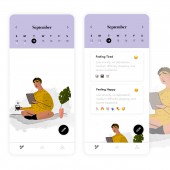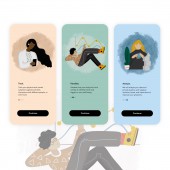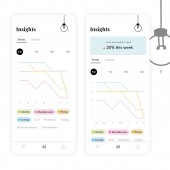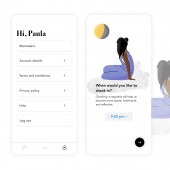
| THE AWARD |
| CATEGORIES |
| REGISTRATION |
| SUBMIT YOUR WORK |
| ENTRY INSTRUCTIONS |
| TERMS & CONDITIONS |
| PUBLICATIONS |
| DATES & FEES |
| METHODOLOGY |
| CONTACT |
| WINNERS |
| PRESS ROOM |
| GET INVOLVED |
| DESIGN PRIZE |
| DESIGN STORE |
| THE AWARD | JURY | CATEGORIES | REGISTRATION | PRESS | WINNERS | PUBLICATIONS | ENTRY INSTRUCTIONS |
Joyster Mobile App by Paula Barcante |
Home > Winners > Design #104051 >Interview |
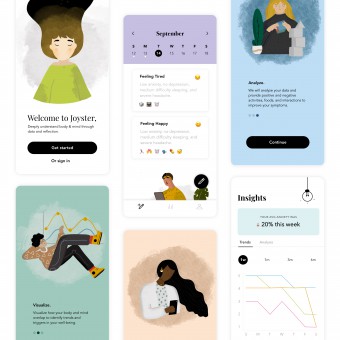 |
|
FS: What is the main principle, idea and inspiration behind your design?
PB: Joyster was created based on my own experience. I was dealing with high anxiety and panic attacks and I was unable to find any good tools or apps that would help me understand my triggers. The principle of the idea is really simple, it's used to help people who suffer from anxiety, depression, or other mental and physical struggles to keep track of how their day to day lives are affecting their symptoms.
FS: What has been your main focus in designing this work? Especially what did you want to achieve?
PB: My main focus was trying to build a platform that was extremely simple to use, but also effective. Journaling is great, but many people do not have time to sit down and journal every day for 30 minutes. Additionally, journals do not give people an overview of how their activities, foods, or people are affecting them in a graph format.
FS: What are your future plans for this award winning design?
PB: Joyster just opened up for Beta, so we are still early days! We will be doing a complete ios and android launch in June 2020. We are overwhelmed with the support and interest we have received.
FS: How long did it take you to design this particular concept?
PB: Joyster took me about 7 months to design end-to-end.
FS: Why did you design this particular concept? Was this design commissioned or did you decide to pursuit an inspiration?
PB: I designed it based on my own experience as well as observing people close to me who needed a tool like this as well. Joyster is a very personal project to me and we really hope that it can help many people.
FS: Is your design being produced or used by another company, or do you plan to sell or lease the production rights or do you intent to produce your work yourself?
PB: Joyster is owned by myself and my co-founder, Steve Viselli, who developed it.
FS: What made you design this particular type of work?
PB: I was dealing with high anxiety and panic attacks for the first time and I was unable to find any good tools or apps that would help me understand my triggers. I started an excel sheet where I would measure my anxiety, panic, and depression levels against my meals, activities, and interactions each day. At the end of week I would graph all of this to see trends. This was when I had a light-bulb moment. For the first time, I was able to actually see what the causes and triggers of my anxiety were.
FS: Where there any other designs and/or designers that helped the influence the design of your work?
PB: Not really. I wanted Joyster to reflect my own work and style as a designer.
FS: Who is the target customer for his design?
PB: The target audience is anyone who suffers from a mental or physical health that would like to keep track of their well-being.
FS: What sets this design apart from other similar or resembling concepts?
PB: A lot of similar concepts makes the experience a lot more complicated than it should be. Additionally, there aren't any apps (I'm aware of) that uses the same kind of algorithm as we do.
FS: Which design tools did you use when you were working on this project?
PB: I used mainly Sketch for designing the User Interface and InVision when user testing.
FS: What is the most unique aspect of your design?
PB: I like to think the most unique aspect of my design are the illustrations. I believe it's important to humanize virtual experiences as much as possible.
FS: Who did you collaborate with for this design? Did you work with people with technical / specialized skills?
PB: I was the only designer on this project.
FS: Is your design influenced by data or analytical research in any way? What kind of research did you conduct for making this design?
PB: When I started Joyster, I did an early concept testing using usertesting.com to receive market validation and interaction feedback.
FS: What are some of the challenges you faced during the design/realization of your concept?
PB: The main challenge was coming up with a brand that felt authentic to me as a designer and had a market fit as well. I went through three different brand ideations before landing on this calm aesthetic.
FS: How did you decide to submit your design to an international design competition?
PB: I received an e-mail from the A'Design Award & Competition inviting me to participate. I wasn't sure what it was at first, but the more I looked into it, the more excited I got.
FS: Thank you for providing us with this opportunity to interview you.
A' Design Award and Competitions grants rights to press members and bloggers to use parts of this interview. This interview is provided as it is; DesignPRWire and A' Design Award and Competitions cannot be held responsible for the answers given by participating designers.
| SOCIAL |
| + Add to Likes / Favorites | Send to My Email | Comment | View Press-Release |

